

The Abbey of Viboldone is an abbey in Viboldone, a frazione of San Giuliano Milanese, in the province of Milan, northern Italy.


The Abbey of Viboldone is an abbey in Viboldone, a frazione of San Giuliano Milanese, in the province of Milan, northern Italy.
The abbey was founded in 1176 and completed in 1348 by the Humiliati, an order of monks, nuns and lay people who worked in the abbey producing wool cloths and cultivated the nearby fields with innovative techniques.
After the suppression of the Humiliati by Pope Pius V (1571), the abbey went to the Olivetan Benedictines, who were forced to leave the abbey in 1773, when Lombardy fell in Austrian hands.
After several years of abandonment, the abbey is currently home to the Community of Madre Margherita Marchi (Benedictine nuns) since 1941.

The façade (finished in 1348) is hut-shaped, with mullioned windows and visible brickwork with white stone decorations, and divided into three sectors by two semi-columns. The entrance portal is in white marble, and is surmounted by a lunette with marble sculptures of the "Madonna with Child between the Saints Ambrose and John of Meda". At its sides, two Gothic niches houses statues of the Sts. Peter and Paul. The door is in dark wood, and dates to the 14th century.
The bell tower has an appearance similar to that of the façade, with frames in cotto and small arcades at the bases of the double and triple mullioned windows. The latter are surmounted by small circular windows.
The interior is rather sober, with few decorations, aside from the extensive fresco decoration of the Giottesque school. It has a rectangular hall plan, with a nave and two aisles with five spans each (the first ones in Romanesque style, while the remaining ones are Gothic with cotto columns and high cross vaults). The arches are ogival.
The fresco decoration includes the Madonna in Maestà with Saints and the large Universal Judgement with, in the middle, Jesus and at his left the Damned, overlook by Satan. Other frescoes, depicting Renaissance musical instruments, are housed in the Music Hall, located in a building annexed to the church.
| Wikimedia Commons has media related to Viboldone Abbey . |

The Certosa di Pavia is a monastery and complex in Lombardy, northern Italy, situated near a small town of the same name in the Province of Pavia, 8 km north of Pavia. Built in 1396–1495, it was once located on the border of a large hunting park belonging to the Visconti family of Milan, of which today only scattered parts remain. It is one of the largest monasteries in Italy.
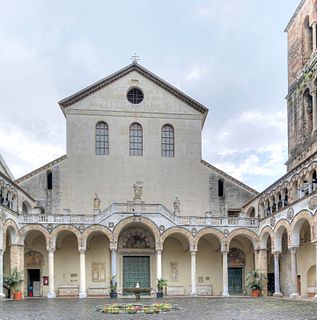
Salerno Cathedral is the main church in the city of Salerno in southern Italy and a major tourist attraction. It is dedicated to Saint Matthew, whose relics are inside the crypt.

Offida is a comune (municipality) in the Province of Ascoli Piceno in the Italian region Marche, located about 80 kilometres (50 mi) south of Ancona and about 12 kilometres (7 mi) northeast of Ascoli Piceno, on a rocky spur between the valleys of the Tesino and Tronto (south) rivers.

Cremona Cathedral, dedicated to the Assumption of the Blessed Virgin Mary, is a Roman Catholic cathedral in Cremona, Lombardy, northern Italy. It is the seat of the Bishop of Cremona. Its bell tower is the famous Torrazzo, symbol of the city and tallest pre-modern tower in Italy.
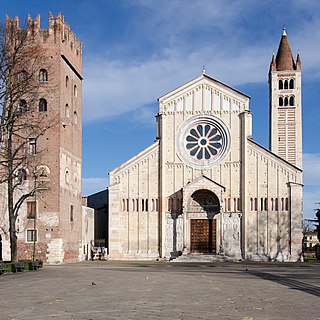
The Basilica di San Zeno is a minor basilica of Verona, Northern Italy constructed between 967-1398 AD. Its fame rests partly on its Romanesque architecture and partly upon the tradition that its crypt was the place of the marriage of Shakespeare's Romeo and Juliet. It stands adjacent to a Benedictine abbey, both dedicated to St Zeno of Verona.

Sant'Anastasia is a church of the Dominican Order in Verona, northern Italy. In Gothic style, it is located in the most ancient part of the city, near the Ponte Pietra.

The Madonna dell'Orto is a church in Venice, Italy, in the sestiere of Cannaregio.

Fiesole Cathedral, officially the Cathedral of Saint Romulus of Fiesole, is a Roman Catholic cathedral in Fiesole, Tuscany, central Italy. It is the seat of the Bishop of Fiesole and is dedicated to Saint Romulus.
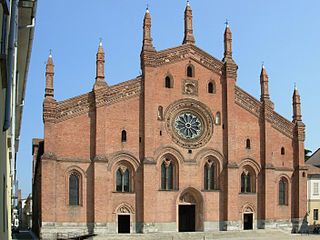
Santa Maria del Carmine is a church in Pavia, Lombardy, northern Italy, considered amongst the best examples of Lombard Gothic architecture. It was begun in 1374 by Gian Galeazzo Visconti, Duke of Milan, on a project attributed to Bernardo da Venezia. The construction followed a slow pace, and was restarted in 1432, being finished in 1461.

Pistoia Cathedral is the main religious building of Pistoia, Tuscany, central Italy, located in the Piazza del Duomo in the centre of the city. It is the seat of the Bishop of Pistoia and is dedicated to Saint Zeno of Verona.

Crema Cathedral is a Roman Catholic cathedral in Crema, northern Italy. Dedicated to the Assumption of the Virgin Mary, it is the seat of the Bishop of Crema.

San Francesco is a church in Lodi, Lombardy, northern Italy, dating to the late 13th century. Its main peculiarity are the two "open sky" double mullioned windows in the façade, which are the first example of a model often repeated in northern Italy in the 14th and 15th centuries.

The Abbey of Santa Maria di Rovegnano is a Cistercian monastic complex in the comune of Milan, Lombardy, northern Italy. The borgo that has developed round the abbey was once an independent commune called Chiaravalle Milanese, now included in Milan and referred to as the Chiaravalle district.

Santa Maria in Strada is a church in Monza, Lombardy, northern Italy.

The Abbey of Vezzolano is an abbey in the territory of Albugnano, Piedmont, northern Italy, in Gothic–Romanesque style.

The Basilica di Sant'Andrea is the church of a monastery in Vercelli, Piedmont, northern Italy, founded in 1219 by Cardinal Guala Bicchieri and completed in 1227. It represents an early example of Gothic architecture in Italy, inspired by Cistercian models and featuring Romanesque elements as well.
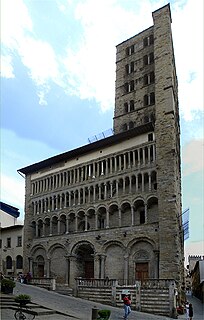
Santa Maria della Pieve is a church in Arezzo, Tuscany, central Italy.

Santa Sofia is the oldest Roman Catholic church structure in the city of Padua, region of Veneto, Italy. It was built in the 10th century on the site of a presumed Mithraeum. A grant was made to bishop Sinibaldo of this church in 1123, which had already been in construction. The Romanesque stone and brick facade was constructed from 1106 to 1127, but the semicircular apse may date from earlier. The interior is now relatively bare.
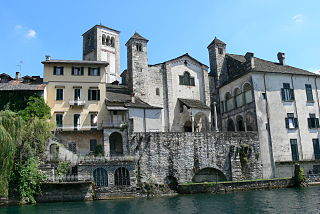
The Basilica di San Giulio is a Roman Catholic church on the small Isola San Giulio in the center of Lake Orta, province of Novara, north-western Italy. It has the status of a minor basilica. Although the island is part of the Orta San Giulio municipality, the basilica belongs to the San Giacomo parish, including the island and a portion of the west coast of the lake in San Maurizio d'Opaglio municipality.
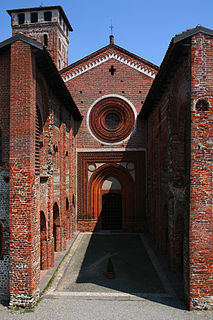
The Abbey of the Saints Nazario and Celso is a monastic complex in the municipality of San Nazzaro Sesia, Piedmont, northern Italy. It consists of a city wall with circular corner towers, a high Romanesque bell tower, a church in Lombard Gothic style and a cloister with a group of 15th-century frescoes dedicated to the stories of St. Benedict.